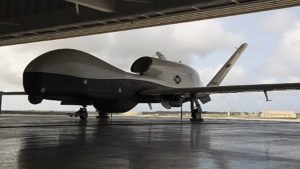The first two MQ-4C Triton unmanned aircraft arrived in Guam for the first deployment of the aircraft in the Pacific theater.
The first Triton unmanned aircraft systems (UAS) squadron, Unmanned Patrol Squadron (VUP) 19, will operate the first two aircraft as the early operational capability (EOC). The EOC group aims to further develop concept of operations and fleet learning for operating a long-endurance, high altitude unmanned maritime aircraft.

The two Tritons arrived at Andersen Air Force Base on Jan. 26 and will fall under Commander, Task Force (CTF) 72, lead for patrol, reconnaissance and surveillance forces in 7th Fleet.
The Tritons will conduct intelligence, surveillance and reconnaissance missions to complement the P-8A Poseidon.
“The inaugural deployment of Triton UAS brings enhanced capabilities and a broad increase in Maritime Domain Awareness to our forward Fleet commanders,” Rear Adm. Peter Garvin, commander of Patrol and Reconnaissance Group, said in a statement.
“VUP-19, the Navy’s first dedicated UAS squadron supported by an outstanding NAVAIR and industry team, is superbly trained and ready to provide the persistent ISR coverage the Navy needs,” he continued.
Capt. Matt Rutherford, commander of CTF-72, said the MQ-4Cs will expand the reach of naval maritime patrol and reconnaissance forces in the Western Pacific.
“Coupling the capabilities of the MQ-4C with the proven performance of P-8, P-3 and EP-3 will enable improved maritime domain awareness in support of regional and national security objectives,” Rutherford added.
This deployment happened significantly later than planned after a crash by a Triton in 2018 due to a mechanical issue where the landing gear did not deploy during a landing (Defense Daily, Sept. 13, 2018).
After the incident, the Navy suspended Triton flights while an investigation was underway. The damage to the aircraft was estimated at over $2 million, classifying it as a Class A aviation mishap (Defense Daily, Sept. 14, 2018).
Before the crash and investigation, the MQ-4C was expected to achieve EOC in 2018 and initial operating capability (IOC) scheduled for 2021. IOC includes four aircraft with a multi-intelligence sensor suite that brings it up to a top secret signals intelligence architecture (Defense Daily, April 9, 2018).
The Navy noted the IOC will have the capacity to support 24/7 operations.
The Navy said the Persistent Maritime UAS program office out of Patuxent River, Md., and aircraft builder Northrop Grumman [NOC] worked closely with VUP-19 to prepare for EOC, completing “extensive operational test and unit level training.”
“This significant milestone marks the culmination of years of hard work by the joint team to prepare Triton for overseas operations. The fielding of the Navy’s premier unmanned aircraft system and its additive, persistent, multi-sensor data collection and real-time dissemination capability will revolutionize the way maritime intelligence, surveillance and reconnaissance is performed,” Capt. Dan Mackin, manager of the Persistent Maritime UAS office, said in a statement.
Last May, the Navy awarded Northrop Grumman a $65 million advance acquisition contract for long-lead components to build and deliver three low-rate initial production Lot 5 MQ-4Cs. Two will be for the U.S. Navy and one for Australia and the work is expected to be finished by June this year (Defense Daily, May 30, 2019).
Then last month, Northrop Grumman won another $252 million modification to procure three more LRIP Triton aircraft in Lot 4 (Defense Daily, Jan. 2).